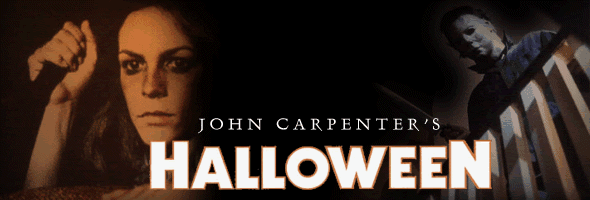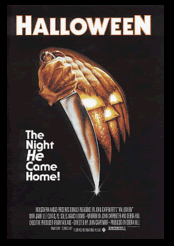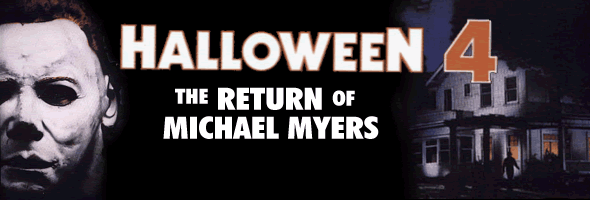
Color, 1978, 93 mins. Directed by John Carpenter
Starring Jamie Lee Curtis, Donald Pleasence, Nancy Loomis, P.J. Soles, Charles Cyphers, Kyle Richards, Brian Andrews / Written by John Carpenter and Debra Hill / Produced by Debra Hill / Music by John Carpenter / Cinematography by Dean Cundey
Format: DVD - Anchor Bay (MSRP $44.98)
Letterboxed (2.35:1) (16x9 enhanced) / Dolby Digital 5.1
Fifteen years ago (ah, love those timeless mad killer movies), little Michael Myers stabbed his sister to death on Halloween night and wound up in an asylum. In the present day, he escapes on October 30 when his doctor, Sam Loomis (Donald Pleasence), comes to visit. Loomis believes Michael is heading back to his hometown, Haddonfield, Illinois, for another night of carnage. Though the actual body count and gore content are refresingly low, Carpenter keeps events moving at a fever pitch thanks to a very sharp script and some spectacularly manipulative mobile camerawork. Unlike many directors who simply use the horror genre as a calling card to "bigger and better" things, Carpenter and company obviously love the genre and honor its rules while creating a few new ones of their own. Amazingly, each setpiece builds perfectly upon the last and creates a cumulative effect of relentless terror during the final half hour, one of the grand tour de forces of '70s filmmaking. Not surprisingly, this remains one of the most profitable independent films ever made and, in the process, revolutionized the process of movie production and distribution.
Few films make better use of widescreen framing than Halloween, though home viewers were unable to see a good scope version until Criterion's special edition CAV laserdisc in 1995. During the shooting of Halloween II, Carpenter also filmed three sequences to insert into the original film for its network premiere on NBC, and Criterion included these fullscreen scenes as supplements on the disc. Anchor Bay subsequently issued a letterboxed version on DVD, containing only the trailer, and the result immediately earned the scorn of many viewers as the most artifact-riddled major film on the DVD market. Obviously anxious to make amends, Anchor Bay prepared a lavish special edition, two disc DVD set. So how does it stack up to previous editions? Most obviously, the transfer (approved by THX, which doesn't count for much these days but is still a nice gesture) blows away the previous DVD, and it's even anamorphically enhanced to provide an even more detailed and enveloping experience. The Criterion laser transfer looked great to begin with, but Anchor Bay's improves upon it even more by providing a smoother, darker, and richer visual texture. One minor quibble: when played non-anamorphic on a standard television, the black letterboxing bars are actually two slightly different shades, with the area roughly inside the 1.85:1 matte area a slightly lighter and bluer hue. It's not a huge visual problem, but it is a strange one. Much more obvious (in a good way) is the 5.1 remix, a startling audio overhaul that allows this film to even scare viewers who know the movie by heart. Carpenter's shameless musical "stings" burst from various speakers, and that unforgettable music has never sounded better. A standard surround and the original mono soundtracks are also included. The disc also features a half hour documentary, Halloween Unmasked 2000, which features interviews with most of the principal players. Though sketchy at times, this featurette makes for a satisfying addition to Myers video memorabilia, and it's nice to see that everyone still holds nothing but fond memories for the film. (The Touch of Evil analogy is especially interesting.) The real coup for Anchor Bay, however, lies on the second disc, available only in a limited pressing. Disc two contains the complete Halloween feature with the extra television footage reinstated back into the film. Though you'd never know it from earlier editions, the TV footage was actually filmed in scope and looks terrific, merging seamlessly into the rest of the film. The expanded version runs 101 minutes, and many a Myers fan will find this treat long overdue. Even this alternate version is 16x9 enhanced (though mono), so hats off for going that extra mile even on the extras. Other bonuses include the original and reissue trailers, TV and radio spots, a still gallery, and a small series of trivia tidbits. And watch out for those menu screens! To put it mildly, Anchor Bay has been doing the creepiest menus around (also see Hell Night, Phenomena, and Demons), and this is no exception. The first disc will also be avaialable separately at a lower price, but the expanded version is really worth the extra money for anyone who can afford it. However, anyone with the CAV laser would be wise to hold on to it for a number of reasons. Most obviously, the laser contains a very entertaining running commentary with Carpenter, Hill, and Curtis, and it's too bad Anchor Bay couldn't license it for their edition. Also, the laser features a number of interesting extras, particularly a snippet from the notorious episode of Sneak Previews in which Siskel and Ebert praise Halloween to the skies while trashing a number of other films like Friday the 13th and I Spit on Your Grave. Obviously it's not worth spending almost $100 on now, but the laser remains a valuable part of any completist's horror movie library. Thankfully, we now also have a definitive edition of the film itself, in an edition that deserves to be watched more often than simply once a year.
Color, 1988, 83 mins. Directed by Dwight H. Little
Starring Donald Pleasence, Danielle Harris, Ellie Cornell, Michael Pataki, Beau Starr, Kathleen Kinmont, Sasha Jenson, George P. Wilbur / Written by Alan B. McElroy / Music by Alan Howarth / Cinematography by Peter Lyons Collister
Format: DVD - Anchor Bay (MSRP $29.95)
Dolby Digital Ultra-Stereo
The strongest of the Halloween sequels, this film repairs much of the damage done by the sluggish and notoriously problematic Halloween II while obviously ignoring the unrelated Halloween III: Season of the Witch. While John Carpenter had nothing to do with this film, which was simply intended as a seasonal cash-in on the famous slasher franchise, most horror fans were pleasantly surprised by the level of craftsmanship on display here. Most of the credit probably belongs to director Dwight Little, who also helmed the flawed but extremely stylish 1989 version of Phantom of the Opera and two of the more visually interesting action films of the period, Rapid Fire and Marked for Death, before settling into a career doing TV series like The Practice. Little obviously knows his stuff, throwing in countless little touches that fans of the original film will appreciate and even pulling off a large number of genuinely effective scares along the way.
On a dark and stormy night (of course), Michael Myers escapes during his transportation from one asylum to another in Illinois. Followed as always by the dogged Dr. Loomis (Donald Pleasence, inexplicably burned only slightly from the final conflagration of the previous Myers entry), Michael heads back to Haddonfield where he stalks his niece, Jamie (Danielle Harris). Of course, everyone who stands in his way meets a grisly end, courtesy of John Carl Buechler's rubbery skull-puncturing latex effects (most of which were mercifully cut before the film's release to ensure an R rating).
Though nowhere near the original, Halloween 4 stands quite nicely on its own and looks even better in the wake of the three substandard sequels which followed it. Alan Howarth's judicious use of the original musical theme works perfectly (seeing this in the theater with a large crowd is a really special experience), and Harris and Cornell make sympathetic young heroines. Most interestingly, this is that rare horror film in which the police are called in early on to the scene, but even that doesn't stop Michael on his rampage. The twist ending, while hardly original to this film, caps things off nicely without resorting to the usual back from the dead killer routine.
Anchor Bay's presentation of Halloween 4 improves on the previous Fox version in every respect. Originally filmed with a hard matte at 1.85:1 (not in scope, surprisingly enough for a Halloween title), the entire image is accurately transferred with much greater clarity and truer colors. While the Fox version had a vaguely gauzy, grainy texture, this version looks quite sharp and colorful, marred only by the limited resources of the film stock used for such a low budget. The Ultra-Stereo soundtrack sounds fine, basically a straight surround-style presentation with music and ambient effects shunted to the exterior channels, and the original theatrical trailer is also included. Anchor Bay is currently at work on a similar edition of Halloween 5, which isn't worth the trouble unless they can find enough unused footage to make it an entirely different film.
The ultimate seasonal horror film, Halloween put a lot of names on the map, most notably director/writer/composer John Carpenter, star Jamie Lee Curtis, and amazing cinemtographer Dean Cundey, all of whom were at their peak with this one. At the time, Halloween justifiably earned a reputation as the scary movie to see and influenced a slew of inferior imitations which continue to plague audiences in the post-modern '90s. And then, of course, there are the sequels... (see review below).
 Meanwhile, three likable teenage girls - Laurie Strode (Curtis), Lynda (P.J. Soles from Carrie and Rock 'n' Roll High School), and Annie (Nancy Loomis from The Fog) - are stalked by Michael as they prepare for a Halloween evening of babysitting, scary movies, and covertly making out with boyfriends. As Michael draws closer and the night grows darker, only one survivor remains to battle for her life against the masked, wordless killer.
Meanwhile, three likable teenage girls - Laurie Strode (Curtis), Lynda (P.J. Soles from Carrie and Rock 'n' Roll High School), and Annie (Nancy Loomis from The Fog) - are stalked by Michael as they prepare for a Halloween evening of babysitting, scary movies, and covertly making out with boyfriends. As Michael draws closer and the night grows darker, only one survivor remains to battle for her life against the masked, wordless killer.

